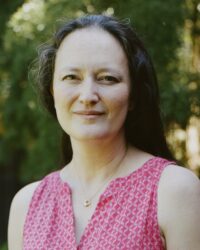
By Isha Nadig
Hope Ishii, a user at the Foundry’s National Center for Electron Microscopy (NCEM) and a research scientist at the University of Hawai‘i at Mānoa, relies on electron microscopes at the Foundry to advance her research on extraterrestrial materials. Materials in space are altered by complicated space weathering that involve multiple physical and chemical processes. Because of this complexity, careful sample preparation and advanced imaging play a key role in understanding their messy atomic composition, structures, and processes which form them. Ishii began her extraterrestrial studies using synchrotron X-ray radiation, but it penetrates through too many layers of the material at once, producing averaged information and hiding fine structural and chemical details of space weathering. Electron microscopy solves this problem by allowing her to probe the sample at the nanometer scale and to visualize different minerals and glasses in the sample with exquisite resolution. Of the relevance of her studies of Apollo 17 samples to human exploration, she says, “If you can understand the properties of materials there [on the Moon], you can understand how and where to find water, or be able to generate it to survive.” Ishii collaborates with space agencies, such as NASA and Japan Aerospace Exploration Agency (JAXA), to understand the origins and processing of samples collected on missions. So far, she and her team have analyzed comet dust and moon soil from NASA’s Stardust and Apollo missions and asteroid soil returned by JAXA’s Hayabusa and Hayabusa2 missions.

The combination of tools and expertise at the Foundry have been instrumental in advancing Ishii’s research. Ishii uses the glove box to handle samples in a clean, air-free environment; the dual beam focused ion beam (FIB) to cut very thin slices of the samples; and the transmission electron microscopes (TEMs) for imaging, structure determination, and mapping of chemistry and oxidation state. “One of the benefits of being able to work at a facility that has multiple tools and glove boxes is you can keep your sample clean, do your analysis, and then put it right back into a dry atmosphere.”
Access to state-of-the-art instrumentation is just one of the benefits to working at the Molecular Foundry. For Ishii, another is the scientific environment. From completing her PhD at the SLAC National Accelerator Laboratory and post-doc at Lawrence Livermore National Laboratory, Ishii is well-acquainted with user facilities and their advantages. “The emphasis on collaborative work is really key,” she remarks. “You’re getting free advice and insight all the time, which means you’re not spending an entire day troubleshooting something instead of getting science done.” She notes the technical staff at the Molecular Foundry offer more than just expertise on instrumentation. What surprised her the most when she first started working at the Foundry was how deeply invested the scientists are in advancing her research. “The staff are not just microscope jockeys. They are really good scientists in their own right.”
Beyond space exploration, Ishii’s research contributes to advances in hydrogen storage. Insights gained from analyzing solar wind-generated hydrogen in extraterrestrial materials can be applied to making hydrogen storage materials function at lower pressures and temperatures for practical hydrogen fuel applications. “It’s fun to see how your science can apply in other areas, and you can morph it with other things.” The same curiosity that sparked her passion for science in her youth now drives her to discover new phenomena and applications. As a first-generation scientist, she finds “the discovery aspect, just learning something new that people didn’t know before” to be most rewarding. With the tools and expertise at the Foundry and her motivation to explore unknown astromaterials, hydrogen fuel storage will be just one of many applications which may emerge from her work.

